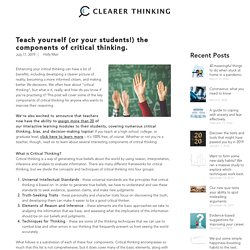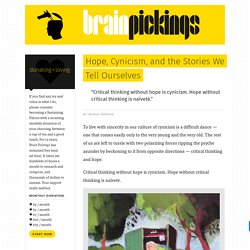

Critical thinking is a constant state of metacognition, measuring evidence, and recognizing when to defer to experts. Teach yourself (or your students!) the components of critical thinking. Enhancing your critical thinking can have a lot of benefits, including developing a clearer picture of reality, becoming a more informed citizen, and making better life decisions.

We often hear about "critical thinking", but what is it, really, and how do you know if you’re practising it? This post will cover some of the key components of critical thinking for anyone who wants to improve their reasoning. We're also excited to announce that teachers now have the ability to assign more than 20 of our interactive learning modules to their students, covering numerous critical thinking, bias, and decision-making topics! If you teach at a high school, college, or graduate level, click here to learn more – it's 100% free, of course.
Whether or not you're a teacher, though, read on to learn about several interesting components of critical thinking. What is Critical Thinking? Universal Intellectual Standards - these universal standards are the principles that critical thinking is based on. 1. 2. Why Facts Don’t Change Our Minds.
A recent experiment performed by Mercier and some European colleagues neatly demonstrates this asymmetry. Participants were asked to answer a series of simple reasoning problems. They were then asked to explain their responses, and were given a chance to modify them if they identified mistakes. The majority were satisfied with their original choices; fewer than fifteen per cent changed their minds in step two. In step three, participants were shown one of the same problems, along with their answer and the answer of another participant, who’d come to a different conclusion. Hope, Cynicism, and the Stories We Tell Ourselves. To live with sincerity in our culture of cynicism is a difficult dance — one that comes easily only to the very young and the very old.

The rest of us are left to tussle with two polarizing forces ripping the psyche asunder by beckoning to it from opposite directions — critical thinking and hope. Critical thinking without hope is cynicism. Hope without critical thinking is naïveté. Finding fault and feeling hopeless about improving the situation produces resignation — cynicism is both resignation’s symptom and a futile self-protection mechanism against it. Blindly believing that everything will work out just fine also produces resignation, for we have no motive to apply ourselves toward making things better. A plant needs water in order to survive, and needs the right amount of water in order to thrive. Let’s consider for a moment the notion of an un-false view of the world — the journalistic ideal of capital-T truth.
Expertise. Discernment. Metacognition. The Forms of Thinking. Criticism. Constructive Feedback. Learning How to Learn. 5 tips to improve your critical thinking. Every day, a sea of decisions stretches before us.

Some are small and unimportant, but others have a larger impact on our lives — for example, ‘Which politician should I vote for?’ ; ‘Should I try the latest diet craze?’ ; or ‘Will email make me a millionaire?’ Below, Samantha Agoos explains 5 tips to improve your critical thinking. We’re bombarded with so many decisions that it’s impossible to make a perfect choice every time. There are many different ways of approaching critical thinking, but here’s one 5 step process that may help you solve any number of problems: 1: Formulate your question. 2: Gather your information. 3: Apply the information — something you do by asking critical questions. 4: Consider the implications. 5: Explore other points of view.
This five-step process is just one tool, and it certainly won’t eradicate difficult decisions from our lives. Watch the TED-Ed Lesson: 5 tips to improve your critical thinking: Animation by Nick Hilditch/TED-Ed. Cognition. Problem Solving. The Need to Say No. Hope. ClearerThinking. Free Courses for Decision Making And Reasoning.